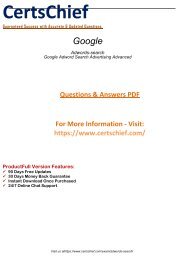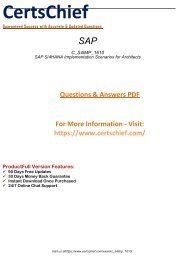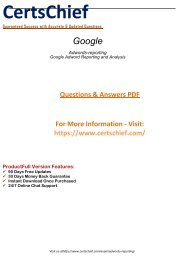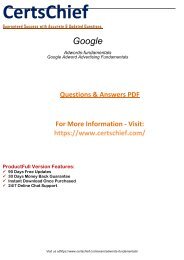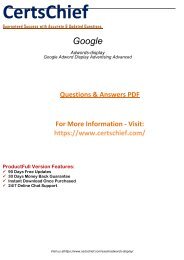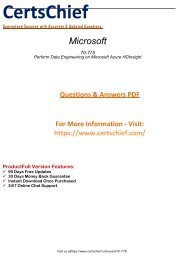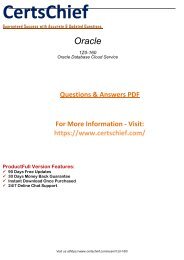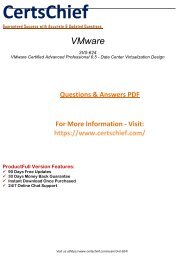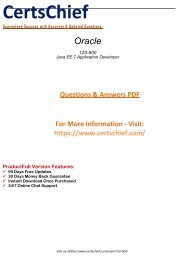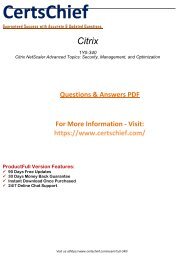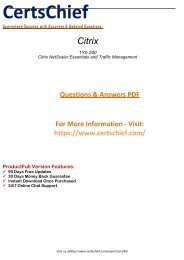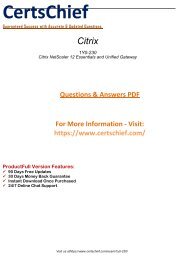1Z0-100
Study units and arrangement materials gave by us to 1Z0-100 Test are approved by the experts and industry specialists. You can without much of a stretch breeze through your accreditation test with our cerebrum dumps and PDF test questions. SpecialistI wish to offer you 20% discount on your purchase. Please use discount voucher “20off2018” on your purchase. For more information please visit here: https://www.certschief.com/exam/1Z0-100/
Study units and arrangement materials gave by us to 1Z0-100 Test are approved by the experts and industry specialists. You can without much of a stretch breeze through your accreditation test with our cerebrum dumps and PDF test questions. SpecialistI wish to offer you 20% discount on your purchase. Please use discount voucher “20off2018” on your purchase. For more information please visit here: https://www.certschief.com/exam/1Z0-100/
Create successful ePaper yourself
Turn your PDF publications into a flip-book with our unique Google optimized e-Paper software.
CertsChief<br />
Guaranteed Success with Accurate & Updated Questions.<br />
Oracle<br />
<strong>1Z0</strong>-<strong>100</strong><br />
Oracle Linux 5 and 6 System Administration<br />
Questions & Answers PDF<br />
For More Information - Visit:<br />
https://www.certschief.com/<br />
ProductFull Version Features:<br />
90 Days Free Updates<br />
30 Days Money Back Guarantee<br />
Instant Download Once Purchased<br />
24/7 Online Chat Support<br />
Visit us athttps://www.certschief.com/exam/1z0-<strong>100</strong>/
Question: 1<br />
Which two statements are true concerning the installation and configuration of the bootloader by the<br />
Anaconda installer, which is then used to boot Oracle Linux?<br />
A. The Linux Loader (LILO) bootloader may be chosen for installation.<br />
B. The bootloader must be password protected and Anaconda prompts for a password in all cases.<br />
C. The Grand Unified Bootloader (GRUB) is the only bootloader used by Oracle Linux.<br />
D. If previously installed operating systems are found on disk partitions that were not overwritten, then<br />
an attempt is made to configure the bootloader to be able to boot them.<br />
E. The bootloader is installed by default in the first partition of the disk.<br />
Answer: A,E<br />
Explanation:<br />
A (not C): Linux boot process from hard drive:<br />
1. PC initializion phase - BIOS, POST.<br />
2. PC starts boot loader - usually grub or lilo.<br />
3. The bootloader locates kernel image on the hard drive.<br />
4. The kernel decompresses and loads itself. Once finished it tries to mount the root filesystem. 5. When<br />
the root filesystem is mounted, /sbin/init is executed and continues booting the system using inittab and<br />
/etc/rc*.d scripts<br />
Question: 2<br />
You want to display the value of a shell variable called service after assigning a value as shown:<br />
SERVICE =ACCT S<br />
Which two settings will display the name of the variable and its value?<br />
A. set | grep service<br />
B. echo $SERVICE<br />
C. env | grep SERVICE<br />
D. env $SERVICE<br />
E. set $SERVICE<br />
Answer: B,C<br />
Explanation:<br />
C: env - set the environment for command invocation<br />
If no utility operand is specified, the resulting environment shall be written to the standard output, with<br />
one name= value pair per line.<br />
Visit us athttps://www.certschief.com/exam/1z0-<strong>100</strong>/
Question: 3<br />
Which statements is true concerning Oracle Linux configuration files for users and groups?<br />
A. The /etc/passwd file contains hashed passwords for each user.<br />
B. The /etc/shadow file contains hashed passwords for each user.<br />
C. The GECOS field in /etc/passwd file may be empty.<br />
D. The /etc/group file contains the group name and the hashed group password.<br />
Answer: B<br />
Explanation:<br />
/etc/shadow file stores actual password in encrypted (one-way hashed) format for user's account with<br />
additional properties related to user password i.e. it stores secure user account information<br />
Question: 4<br />
Examine these statements and their output taken right after successful install of Oracle Linux:<br />
[root@FAROUT /] rpm –q firstboot<br />
Firstboot -1.110.10-1.0.2.e16.x86_64<br />
[root @FAROUT /] # chkconfig - - list firstboot<br />
Firstboot 0:off 2:off 3:off 4:off 5:off 6;off<br />
[root@FAROUT /] # /etc/sysconfig/firstboot<br />
RUN_FIRSTBOOT=NO<br />
What is the conclusion?<br />
A. The option to run firstboot was deselected during Oracle Linux installation.<br />
B. The system was installed with desktop graphical packages and rebooted and the firstboot utility ran<br />
successful.<br />
C. Firstboot never ran in any run level because the service is turned off for all run levels.<br />
D. The system was installed without selecting desktop graphical packages, thereby disabling firstboot<br />
from running.<br />
Answer: A<br />
Explanation:<br />
Firstboot is set to off for all levels.<br />
Example:<br />
The rm command below remove or delate the firstboot file in order to make sure the firstboot program<br />
running when we restart or reboot the Fedora machine.<br />
[root@fedora ~]# rm /etc/sysconfig/firstboot<br />
rm: remove regular file `/etc/sysconfig/firstboot'? y<br />
[root@fedora ~]#<br />
Visit us athttps://www.certschief.com/exam/1z0-<strong>100</strong>/
Then check and make sure that firstboot program or firstboot service is run when your Fedora<br />
startup/boot up.<br />
Check firstboot services<br />
[root@fedora ~]# chkconfig --list firstboot<br />
firstboot 0:off 1:off 2:off 3:off 4:off 5:off 6:off<br />
[root@fedora ~]#<br />
Question: 5<br />
Which three settings can be controlled by using the chage breemar command as the root user, to<br />
modify the parameters in the /etc/shadow file?<br />
A. The expiration date of the breemar account<br />
B. The number of days after the breemar account is locked, that it becomes expired<br />
C. The maximum number of days that must elapse between password changes by the user breemar<br />
before the password becomes invalid<br />
D. The number of days after the breemar account is locked, that it becomes unlocked<br />
E. The minimum number of days that must elapse between password changes by the user breemar<br />
F. The maximum number of failed login attempts on the breemar account before the account is locked<br />
Explanation:<br />
A: chage -E, --expiredate EXPIRE_DATE<br />
Set the date or number of days since January 1, 1970 on which the<br />
user's account will no longer be accessible.<br />
CE: You need to use chage command to setup password aging.<br />
The chage command changes the number of days between password changes<br />
and the date of the last password change. This information is used by<br />
the system to determine when a user must change his/her password.<br />
Question: 6<br />
Answer: A,C,E<br />
Examine this extract from the /etc/ssh/sshd_config file:<br />
passwordAuthentication no<br />
What is the effect of this parameter settings on the use of openSSH commands on both the client and<br />
server?<br />
A. Passwords are not required and no ssh-keygen is required either. Only passphrase are required.<br />
B. Client users whose keys are not in the authorized_keys file on the server are unable to use passwords<br />
to authenticate themselves to the server.<br />
C. The ssh daemon does not ask for a password before starting or stopping the sshd service.<br />
D. Client users whose keys are not in the authorized_keys file on the client are unable to use passwords<br />
to authenticate themselves to the server.<br />
Visit us athttps://www.certschief.com/exam/1z0-<strong>100</strong>/
Answer: B<br />
Explanation:<br />
If you set PasswordAuthentication to no, you will no longer be able to use a login and password to<br />
authenticate and must use a login and public key instead (if PubkeyAuthentication is set to yes).<br />
Question: 7<br />
Which four statements are true about software on the Oracle Public YUM server?<br />
A. It contains Oracle Linux installation ISO images.<br />
B. It contains Oracle Linux binary RPM packages.<br />
C. It contains Oracle Linux errata packages.<br />
D. It contains Oracle Linux source RPM packages.<br />
E. It contains beta Oracle Linux software packages.<br />
F. It does not contain Unbreakable Enterprise Kernel packages.<br />
Answer: B,C,D,F<br />
Explanation:<br />
The Oracle public yum server offers a free and convenient way to install the latest Oracle Linux packages<br />
as well as packages from the Oracle VM installation media via a yum client.<br />
Oracle provides all errata and updates for Oracle Linux via the Public Yum service, which includes<br />
updates to the base distribution, but does not include Oracle-specific software.<br />
F: By default, all new installations of Oracle Linux 6 Update 5 are automatically configured to use the<br />
public yum update service. If you subsequently register the system with ULN, the public yum service is<br />
automatically disabled.<br />
Question: 8<br />
This MDADM output:<br />
Visit us athttps://www.certschief.com/exam/1z0-<strong>100</strong>/
Which two aspects can be determined from this output?<br />
A. A device failed and has been removed from this RAID set.<br />
B. It is no longer possible to write to this RAID set.<br />
C. Read and write performance is no longer optimal on this RAID set.<br />
D. This RAID set was built without a spare device.<br />
E. Only Write performance is no longer optimal on this RAID set.<br />
Answer: A,D<br />
Question: 9<br />
Examine the command on its output:<br />
[root@FAROUT ~] # modprobe –v nfs<br />
Visit us athttps://www.certschief.com/exam/1z0-<strong>100</strong>/
Insmod /lib/modules/2.6.39-<strong>100</strong>.0.12.e16uek.x86_64/kernel/fs/nfs_common/nfs_acl.ko insmod<br />
/lob/modules/2.6.39-<br />
<strong>100</strong>.0.12.e16uek.x86_64/kernel/net/sunrpc/auth_gss/auth_rpcgss.ko<br />
Insmod /lib/modules/2.6.39-<strong>100</strong>.0.12.e16uek.x86_64/kernel/fs/fscache/fscache/ko<br />
Insmod /lib/modules/2.6.39-<strong>100</strong>.0.12.e16uek.x86_64/kernel/fs/locked.ko<br />
Insmod /lib/modules/2.6.39-<strong>100</strong>.0.12.e16uek.x86_64/kernel/fs/nfs/nfs.ko<br />
Which two statements are true about the modprobe command?<br />
A. It will load the nfs module if all the modules upon which it depends have been loaded.<br />
B. It displays the dependency resolution for the nfs module and loads all the modules upon which nfs<br />
depends before loading the nfs module.<br />
C. It verifies that the nfs module and all other modules that depend on the nfs module are installed.<br />
D. It displays the dependency resolution that would occur if the nfs module were to be loaded using<br />
modprobe nfs.<br />
E. It only loads the nfs module if all the modules upon which it depends have not been loaded yet.<br />
Answer: A,B<br />
Question: 10<br />
What is the main advantage of the Oracle Unbreakable Enterprise Kernel compared with the Red Hat<br />
compatible kernel?<br />
A. It is more secure and, therefore, more difficult to hack.<br />
B. It has a lower Mean Time Between Failures.<br />
C. It provides higher availability for applications by reducing Mean Time to Recovery.<br />
D. It scales better for more CPUS, memory, and Infiniband network connections.<br />
Answer: D<br />
Explanation:<br />
The Unbreakable Enterprise Kernel, for those who want to leverage the latest features from<br />
mainline Linux and boost performance and scalability.<br />
The Red Hat Compatible Kernel, for those who prefer strict Red Hat kernel ABI (kABI)<br />
compatibility.<br />
Question: 11<br />
Examine this output:<br />
# df –t nfs<br />
FilesystemSizeUsedAvailUse%Mounted on<br />
o16:export30G21G7.6G74%/mnt<br />
# 1s -1 /mnt/nfs.sh<br />
Visit us athttps://www.certschief.com/exam/1z0-<strong>100</strong>/
-rwxr-mr-x. 1 root root 22 May 8 16:37 /mnt/nfs.sh<br />
# file /mnt/nfs.sh<br />
/mnt/nfs.sh: Bourne-Again shell script text executables<br />
# /mnt/nfs.sh<br />
bash: /mnt/nfs.sh: Permission denied<br />
What is the reason for the error?<br />
A. The file system was exported on host o16 using the ROOT_SQUASH option.<br />
B. The /export filesystem was mounted with the NOEXEC option on host o16.<br />
C. The filesystem mounted on /mnt was mounted with the NOEXEC option.<br />
D. The filesystem was exported on host o16 by using the NO_ROOT_SQUASH option.<br />
Question: 12<br />
Answer: C<br />
Which two software packages are prerequisites for enabling the configuration and use of a Network<br />
information Service (Nis) client?<br />
A. nis-tools<br />
B. slapi-nis<br />
C. ypbind<br />
D. nisserv<br />
E. nisbind<br />
F. yp-tools<br />
Answer: C,F<br />
Explanation:<br />
ypbind finds the server for NIS domains and maintains the NIS binding information. The client (normaly<br />
the NIS routines in the standard C library) could get the information over RPC from ypbind or read the<br />
binding files.<br />
Question: 13<br />
You recently updated the strace package to the latest version as shown:<br />
Visit us athttps://www.certschief.com/exam/1z0-<strong>100</strong>/
Visit us athttps://www.certschief.com/exam/1z0-<strong>100</strong>/
What is the outcome of running this command?<br />
A. It downgrades the strace package to version 4.5.19-1.6.e16.<br />
B. It downgrades strace package to version 4.5.19-1.11.e16_3.2.<br />
C. It fails with an error because you cannot downgrade a package using the yum command.<br />
D. It fails with an error because there are multiple versions available to which Yum can downgrade the<br />
strace package.<br />
E. It will prompt you to select a version of the strace package that you want to downgrade.<br />
Answer: A<br />
Visit us athttps://www.certschief.com/exam/1z0-<strong>100</strong>/
Powered by TCPDF (www.tcpdf.org)<br />
For More Information - Visit:<br />
https://www.certschief.com/<br />
20% Discount Coupon Code:<br />
20off2018<br />
Visit us athttps://www.certschief.com/exam/1z0-<strong>100</strong>/<br />
http://www.certschief.com/exam/0B0-104/<br />
Page | 1



